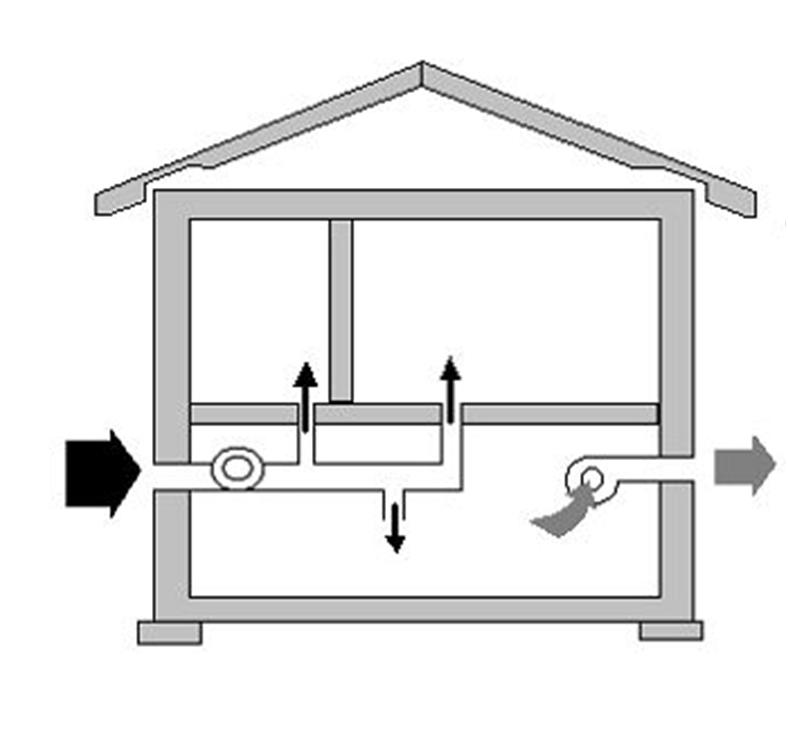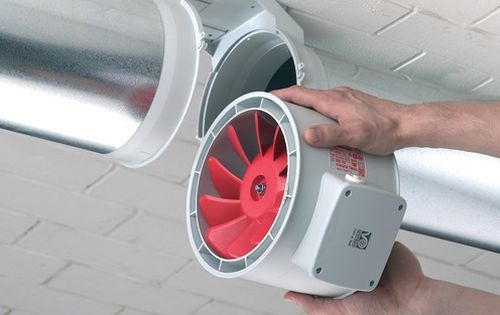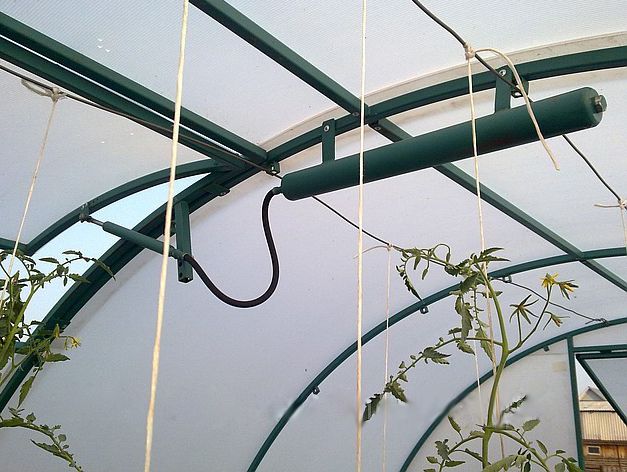- The need for ventilation in the sauna
- Basic rules for arranging ventilation in a sauna
- Natural ventilation of the sauna
- Mechanical ventilation in the sauna
- Forced air outflow
- Forced air flow
- Simple and effective schemes for combined sauna ventilation
- Scheme No. 1
- Scheme No. 2
- Scheme No. 3
- Sauna ventilation scheme, taking into account utility rooms and calculations
- Calculation of air exchange and the diameter of the air ducts in the sauna
- The role of the stove in sauna ventilation
- Sauna air supply
- Providing air outflow in the sauna
- Sauna chimney insulation
The need for ventilation in the sauna
Do you need ventilation in the sauna? After all, precious heat is removed outside along with the air stream. This is the reasoning of an ignorant person.
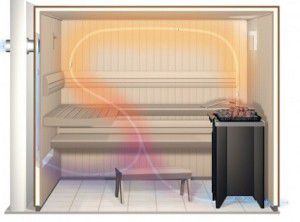
In fact, it's hard to breathe hot air, it becomes a little easier if the air is dry. But in the closed room of the sauna, an abundance of moisture is released by sweating people. If you take a bath broom in your hands, then the humidity rises instantly and significantly. It is simply impossible to breathe, and such a procedure cannot be called wellness. First of all, the heart and blood vessels are affected, therefore ventilation is needed in every sauna to regulate humidity and supply oxygen.
Most often, a shower room and a relaxation room are also adjacent to the steam room. These sauna rooms need ventilation. With high humidity, it is difficult to breathe, it is impossible to dry out and dry off. In the absence of air exchange, the walls of the room will eventually become covered with mold, an unpleasant odor will appear. Wooden structures will rot; instead of 20 years, the sauna will last four times less.
The musty atmosphere and condensation on the walls or ceiling indicate that ventilation is not in order. Read on to learn how to properly ventilate any sauna.
Basic rules for arranging ventilation in a sauna

Maintaining a high temperature and having clean air. Here are the main requirements for ventilation in a sauna. In just 1 hour, the air in a small room must be imperceptibly exchanged at least 4 times, so the ventilation system in the sauna is created according to special rules. The portions of fresh air must be mixed with the hot air of the room. The slightest mistakes in calculations or installation threaten "drafts" or stuffiness. We will tell you about the most effective and frequently used schemes, show you how to do sauna ventilation with your own hands.
The ventilation device in the sauna can be mechanical, natural or combined. The first option for ventilation of a sauna in a cottage is quite expensive, therefore forced exhaust air outflow is more popular. Fresh air from the street is drawn into the sauna when the pressure drops due to the operation of the exhaust fan.
The combined ventilation scheme in the sauna is good in that it does not require a cross-arrangement of the exhaust grilles, and this is a necessary condition for the natural ventilation in the sauna to work. The video covers the process of placing vents in convenient locations. The system must ensure thorough mixing of hot and cold air streams. Otherwise, the temperature difference in the room will be too noticeable.
Ventilation laws in saunas:
- The diameter of the exhaust pipe must not be less than the diameter of the supply pipe, this is the norm;
- The cross-sections of the pipes are selected in proportion to the volume: there are 24 centimeters of the cross-sectional area per 1 cubic meter of the room;
- It is forbidden to set the outflow and inflow strictly opposite each other;
- Sauna vents are equipped with ventilation valves to reduce or increase the air flow.
Failure to follow any of the rules will lead to disruption of air flow and inefficient system operation. How to make ventilation in a sauna with your own hands correctly?
Natural ventilation of the sauna
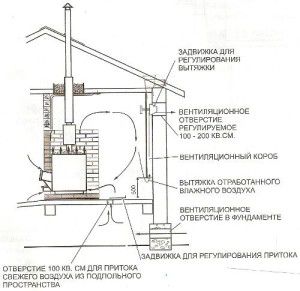
Natural ventilation of the sauna room is ensured by the pressure difference between the outside and the room. The advantage of this scheme is the low cost of installation and the absence of operating costs. Such ventilation in the sauna can be equipped with your own hands.
Natural ventilation can be carried out by:
- aeration;
- wind pressure.
The principle of aeration is the penetration of air from the street through vents in the lower part of the room. Rising up, it "squeezes" hot masses through the air duct. This is a good ventilation method for very hot saunas with lots of steam. In such conditions, air exchange is quite intense. Diagrams and photographs of ventilation in a sauna clearly demonstrate the process of movement of cold and hot air masses.
Wind pressure is possible only in log buildings. The air pressure in the room is provided by strong gusts of wind, which create a vacuum on the leeward side. Through the gaps between the logs, air comes out on one side and enters on the other.
It is impossible to regulate the intensity of ventilation in such a room: in case of strong winds, there may be a draft, sufficient temperature cannot be maintained. A photo-diagram of natural ventilation in the sauna is attached.
Mechanical ventilation in the sauna
Mechanical, or forced ventilation in the sauna is installed when there is no way to organize natural inflow or outflow. Equipment for forced ventilation in a sauna is rather complicated and expensive: fans, air filters, heaters, coolers.
Forced air outflow
With a forced ventilation system in the sauna, exhaust air is blown out by exhaust fans. The air is filtered before being discharged outside.
There is an urgent need for forced evacuation of air in saunas with large pools, public institutions that receive many visitors, and washing rooms.
The system removes gases, steam, odors, providing visitors with clean and fresh air.
Forced air flow
The inflow with mechanical ventilation of a wooden sauna is compulsory. In some cases, it is impossible to provide a natural flow of fresh air from the street. Then use the supply system. It is quite complex and contains a noise reduction mechanism, a supply chamber, check valves, diffusers and distribution grilles.
As a rule, the air is heated and filtered before being supplied.
Simple and effective schemes for combined sauna ventilation
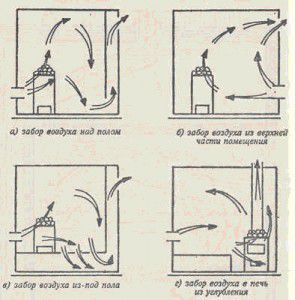
The diagrams given by us clearly explain how to properly ventilate the sauna with your own hands.
Scheme No. 1
The inlet is installed directly behind the firebox, 0.2 m above the floor. The exhaust is planned on the opposite wall, at the same height. The air from the street passes through the hot stove, rushes up to the ceiling. As the temperature decreases, the air flow drops and reaches the exhaust vent.
With such a ventilation device, a high temperature and excellent heating are provided in any sauna.
Scheme No. 2
This ventilation is good for a sauna in a cottage, when only one wall of the room faces the street.
Both the outlet and the inflow are on the outer wall directly opposite the firebox. At a height of 0.2 m from the floor, supply air, 0.2 m from the ceiling - extract air with a built-in fan.
The flow of cold air cuts into the hottest part of the stove, makes a cycle around the room and goes out through the hood to the outside.
Scheme No. 3
Provides gentle warming up of the room.The air supply is installed behind the firebox at the level of 0.5 meters from the floor. A hood with a fan on the opposite wall is 0.2 m from the floor.
Air masses move in a circle: they are heated from the stove, rise, fall and hit the exhaust fan. Air movement in this scheme is not so intense, so the temperature in the room is uniform, a gradual, uniform heating is guaranteed.
It is possible to combine forced ventilation in a wood-fired sauna with natural outflow. The supply air creates an increased pressure in the room, which accelerates the removal of waste through the ventilation grilles. The air flow is regulated by the ventilation flaps in the sauna. It is quite possible to design such a sauna ventilation system with your own hands, having some construction skills.
Sauna ventilation scheme, taking into account utility rooms and calculations
This scheme takes into account not only the steam room, but also the washing department and the rest room. Below we give an explanatory video of ventilation in the sauna.
- steam room - equipped with natural ventilation;
- washing - mechanical extraction;
- rest room - natural inflow and outflow;
- utility room - mechanical hood, started by a light switch.
Calculation of air exchange and the diameter of the air ducts in the sauna
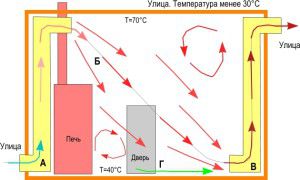
It will not be possible to make ventilation in the sauna "like a neighbor's". Accurate calculations are required. At the design stage of forced ventilation, air exchange is determined. This is the volume of air that must be replaced in a given room in 1 hour.
Air exchange = Oh x K,
Where ABOUT - the volume of air in the room,TO - the frequency of air exchange.
The air exchange rate is a value determined for each type of premises:
- steam room – 5;
- shower room – 50;
- restroom – 3;
- massage – 5.
The calculated figure is rounded up to 0 or 5 after the decimal point.
A balance must be maintained between the inflow and outflow values. Therefore, when, according to the calculations, the inflow is greater, the extraction rate also increases.
Taking into account the obtained values, the diameters of the air channels are calculated.
The cross-sectional shape of the air ducts depends on the design and type of ventilation, but round ducts are easier to install. The elbows are connected to each other using sauna fittings. Ventilation valves are purchased in any large construction supermarket along with all the necessary consumables.
When selecting the power of the fans, it is imperative to leave a reserve of air exchange. The total power of the supply fans should actually be 6 - 10% less than the power of the extract fans. This ensures a complete "extraction" of the used air from the room.
The difference in performance is compensated by natural inflow through cracks in walls and doors.
The role of the stove in sauna ventilation

Specialized equipment ensures optimal ventilation parameters in the sauna. Allows you to set the desired temperature and humidity, supply capacity and heating. However, such ventilation in a sauna cannot be installed with your own hands, and high-tech equipment is very expensive. Therefore, most owners use traditional methods that have worked well for centuries.
And with such technologies, the air flow is provided by the stove. Most often, the firebox is equipped in the steam room itself or in an adjacent room. In the second case, heating is performed by a combustion tunnel. As a rule, metal furnaces are installed in saunas, which are lined with stone or brick. When lining, you should leave gaps that provide a small flow of air. The gap between the brick and the stove is left up to 1 cm. The front surface of the firebox is faced with brick in three rows.
Sauna air supply
The air supply to the oven is provided by a special air duct located under the floor. The outlet is made as close to the firebox as possible.The duct for the ventilation duct is equipped with a diameter of 1/5 more than the cross-section of the chimney. The air supply must be directly from the street, so that it is really fresh, without additional basement odors.
You can assemble such ventilation in the sauna with your own hands. A box with access to the street is installed along the plinth. The inner section is closed with a grid, and the outer one with a mesh, so that insects or rodents do not fall into it.
When the firebox enters the steam room, one channel should be equipped for the inflow, the other for convection. Many people hide the bottom box under the podium on the floor. The stove is installed on it, a metal sheet is preliminarily placed in order to avoid fire. The stove is faced with bricks, after which a screen with two convection doors is erected. Through them, heat spreads from the stove to the room, and fresh air also penetrates.
Providing air outflow in the sauna
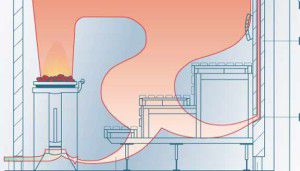
The outflow of air is carried out by an exhaust ventilation duct located diagonally relative to the supply duct. This design guarantees excellent ventilation of the steam room. If the wall of the lining of the stove goes into an adjacent room, it is necessary to equip a convection door here as well.
The outlet of the branch channel is equipped 20 - 25 cm from the floor. Then the pipe goes up to the ceiling and is led out. It is most convenient to use plastic ventilation pipes. For beauty, they are covered from above with boxes made of wooden lining. Most often, boxes with a diameter of 125 sq. cm.
The lower doors do not close during firing up. Warm air will be drawn through the upper ones, partially falling back into the firebox and warming up again. This phenomenon is called oven runaway. Having achieved intensive combustion, the lower doors are closed, while the upper ones are left open.
Through ventilation, cold air is supplied under the firebox, its temperature rises and through the upper doors it goes to the steam room. Thus, the entire volume of air in the steam room is heated completely, down to the lowest layers. After that, hot air masses will be squeezed out cold into the rest room, washing room, and so on.
Thus, heating is provided at the same time, look at the photo of ventilation in the sauna.
Sauna chimney insulation
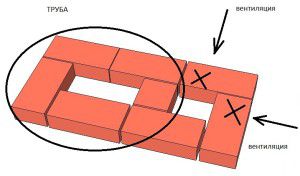
Complete thermal insulation of the ventilation duct pipe reduces the flow of heat into the room. The use of sandwich pipes in the sauna impairs ventilation and smoke removal. But the chimney from the stove can be effectively used to ventilate the sauna in the cottage.
Of course, the metal chimney is not left open. The best option is a brick casing with a blowing hole left in the 2nd row of the masonry. Another hole is left at the top and a heat pump is obtained. It works wonderfully as part of the ventilation of the cottage sauna and accelerates heating.
When constructing ventilation in a sauna, it is important to understand that each room and each stove has its own "character". Therefore, all the recommendations received must be adjusted for each specific case. There is no universal ventilation scheme in a wooden sauna. Not knowing how to make ventilation in the sauna, you should not even take on this difficult task.
For details of the ventilation scheme in the sauna, see the video.



